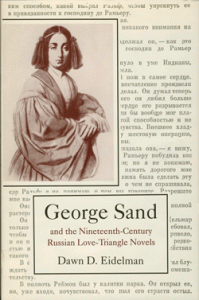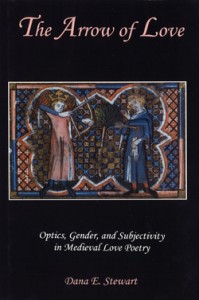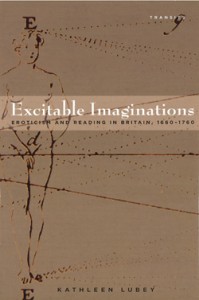With Valentine’s Day just around the corner, love is in the air! —And amongst the pages of a few of our books here at the Bucknell University Press. Weeding back through our database, I came across three books in particular that revolve around the subjects of love and desire. From the beginnings of scandalous love-triangles in fiction to the lyrical love subjects of medieval poetry to erotic literature, these three titles—George Sand in the Nineteenth-Century Russian Love-Triangle Novels, The Arrow of Love, and Excitable Imaginations—cover a spread of topics and analyses that delve deep into the spirit of Cupid’s arrow.
George Sand and the Nineteenth-Century Russian Love-Triangle Novels; by Dawn D. Eidelman (1994)
This first title addresses a series of engaging questions. How did a French female novelist alter the course of history in another country? Why were the chief proponents of the Women Question in nineteenth-century Russia exclusively men? How was the call for reform of women’s education tied to the proletariat cause which ushered in the Russian revolution? These are the few of the issues raised in this study of the impact of George Sand’s influence on nineteenth-century Russia.
Dawn Eidelman examines the ironic relationship of women and fiction in nineteenth-century Russia by considering the love-triangle novels that evolved out of Sand’s scandalous and precedent-setting romance novels. Eidelman explores the issues of desire and culpability and the manner in which they relate to the texts, as well as to the sociopolitical climate of the times. An interesting read to be sure!
The Arrow of Love: Optics, Gender, and Subjectivity in Medieval Love Poetry; by Dana E. Stewart (2003)
The Arrow of Love examines visual encounters in medieval lyrics, exploring the ways in which poets employed contemporary optical theory both to revitalize classic topoi, such as Cupid’s arrow, and to construct and develop subjectivities and gender roles. In the un-confessed or unrequited love that is so frequently the focus of medieval lyrics, an exchange of glances is often the primary contact between the lover and the beloved. As medieval poets sought new ways to describe visual interactions, many turned to the rapidly growing field of optical theory, which offered not only an array of images and metaphors but also models for the perceiving subject that could be adapted to poetic use. In particular, optical imagery and paradigms afforded poets a new approach to the roles of the languishing male and his powerful beloved.
Issues such as the relationship between the eyes and the heart, the power of the beloved’s glance, and the image of the beloved cherished by the lover in his heart have received attention from love poets since Classical Antiquity; this book shows how such themes are reinterpreted in medieval poetry in terms of contemporary advancements in the science of optics. In addition, many medieval poets wrote of light, rays, or spirits exiting from and/or entering the eyes of lyric lovers and their ladies; this study provides parallel accounts of these phenomena in contemporary works on optics and natural magic, and discusses the extent to which poets drew upon these non-literary descriptions.
Optical material did not merely serve to make poetry more technically detailed; frequently, it was employed to develop subjectivity and to portray power relations between the poet-lover and his beloved. For example, in some medieval optical treatises, vision is portrayed as an outwardly directed or even aggressive action; in others, it is described as a sort of painful intrusion upon the eye. This study explores how poets appropriate one or, in some cases, both of these models, often utilizing technical aspects of the theories in order to depict the one who is looking either as a powerful presence with a forceful, penetrating glance, or as a passive victim, assaulted by an image or even by the piercing glance of another.
Poets considered include Chrétien de Troyes, Giacorno da Lentini, Guido Cavalcanti, and Dante, authors whose use of optical material was particularly extensive and original. Medieval transformations of imagery involving the eyes persisted in literature for centuries; an epilogue considers the fate of these transformations in Renaissance poetry.
The eyes are the window to the soul, and have a way of communicating beyond words. It is interesting to consider that they are connected to the heart, and hold such power when it comes to love, even in the medieval period.
Excitable Imaginations: Eroticism and Reading in Britain, 1660-1760; TRANSITS; by Katherine Lubey (2012)
Excitable Imaginations branches off onto a racier subject, offering a new approach to the history of pornography. Looking beyond a counter-canon of bawdy literature, Kathleen Lubey identifies a vigilant attentiveness to sex across a wide spectrum of literary and philosophical texts in eighteenth-century Britain. Esteemed public modes of writing such as nationalist poetry, moral fiction, and empirical philosophy, as well as scandalous and obscene writing, persistently narrate erotic experiences—desire, voyeurism, seduction, orgasm. The recurring turn to sexuality in literature and philosophy, she argues, allowed authors to recommend with great urgency how the risqué delights of reading might excite the imagination to ever greater degrees of educability on moral and aesthetic matters. Moralists such as Samuel Richardson and Adam Smith, like their licentious counterparts Rochester, Haywood, and Cleland, purposefully evoke salacious fantasy so that their audiences will recognize reading as an intellectual act that is premised on visceral pleasure. Eroticism in texts like Pamela and Memoirs of a Woman of Pleasure, in Lubey’s reading, did not compete with instructive literary aims, but rather was essential to the construction of the self-governing Enlightenment subject.
This book seems to take a unique perspective on the evolution of all sorts of erotic texts. A provocative read!
As you get in the spirit of the upcoming holiday, you may want to reconsider it as something beyond a day of romance and chocolates. Just from these few books, we see that love is a complex topic with many angles to be explored. The intrigue of love-triangles, the power of a glance in medieval love poetry, and the evolution of eroticism are only a few of the subjects that fill the great chasm of mysteries surrounding the enigma that is love.
Interested in more?
Check out these books on our database: http://www.bucknell.edu/universitypress.xml
–Alana Jajko, 2014-15 Cynthia Fell Intern


